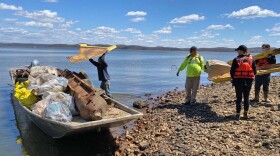The U.S. Army Corps of Engineers is proposing to place and test barriers and deterrents to stop the spread of invasive carp species along the Tennessee and Cumberland rivers and other connected waterways, something that advocates trying to combat the fish say has been years in the making.
The USACE in its proposal released Monday wants to place the barriers and deterrents at up to 10 sites, all of them various locks and dams, ranging from the Kentucky Lake Lock and Dam in western Kentucky to the Fort Loudoun Dam in eastern Tennessee.
Some of the carp deterrents in the proposal include an electrical current barrier, infusing the water with carbon dioxide and using what’s known as a Bio-Acoustic Fish Fence, or BAFF. The experimental BAFF fence uses a combination of bubbles, sound and light to deter invasive carp from crossing a river lock. Federal and state officials have been testing a BAFF fence at the Barkley Lock and Dam since 2019.

Lyon County Judge-Executive Wade White, who’s been a prominent advocate of removing the fish from waterways in western Kentucky, said the proposal is the first step to blocking the carp from coming through the Ohio River into Kentucky and Tennessee waterways.
“Not only do we want to block them here but we want to block them further up the system in order to stop them from doing to their waters what they've done to ours,” White said.
Invasive carp, which make up several fish species native to Asia, are known to be voracious eaters of organisms like zooplankton in the water and can reproduce in large numbers quickly. The carp subsequently can outcompete native fish and impact river ecosystems, fisheries and tourism along the rivers.
The fish were brought to the U.S. to be grown in aquaculture ponds and eventually got into the Mississippi River through flooding and accidental releases, making their way up into the Ohio River. According to a map of the Tennessee Wildlife Resources Agency, the invasive carp have made their way down the Tennessee and Cumberland watersheds.
Tennessee Wildlife Federation CEO Michael Butler said the carp can be a hazard to boaters as the heavy fish can fly out of the water and hit people when disturbed by motors. Black carp, one of the species of invasive carp, can also be a threat to native mussels in Tennessee’s Duck River.
“It has different species of mussels that are globally rare and only occur in the Duck River,” Butler said. “This fish feeds exclusively on mussels and has the real opportunity to mess things up.”
Butler thinks the USACE proposal is a “real positive move” and shows the agency’s commitment to do something about the issue. The pilot program for the USACE to explore these barriers was authorized in the Water Resources Development Act of 2020. But Butler said there hasn’t been federal funding tied to implementing the barriers, which remains a future challenge.
“While that language authorizes up to 10, we don't have any funding for even one. So, it's like we got to figure out how to eat this elephant one bite at a time,” Butler said.
The USACE is proposing the barriers through the National Environmental Policy Act process, which requires a public comment period. The public and other stakeholders can offer comments to the USACE until Oct. 26 by emailing corpslrnplanningpubliccom@usace.army.mil or sending a mailed letter to 110 9th Ave. South, Room A-405, Nashville, TN, 37203-3817.





